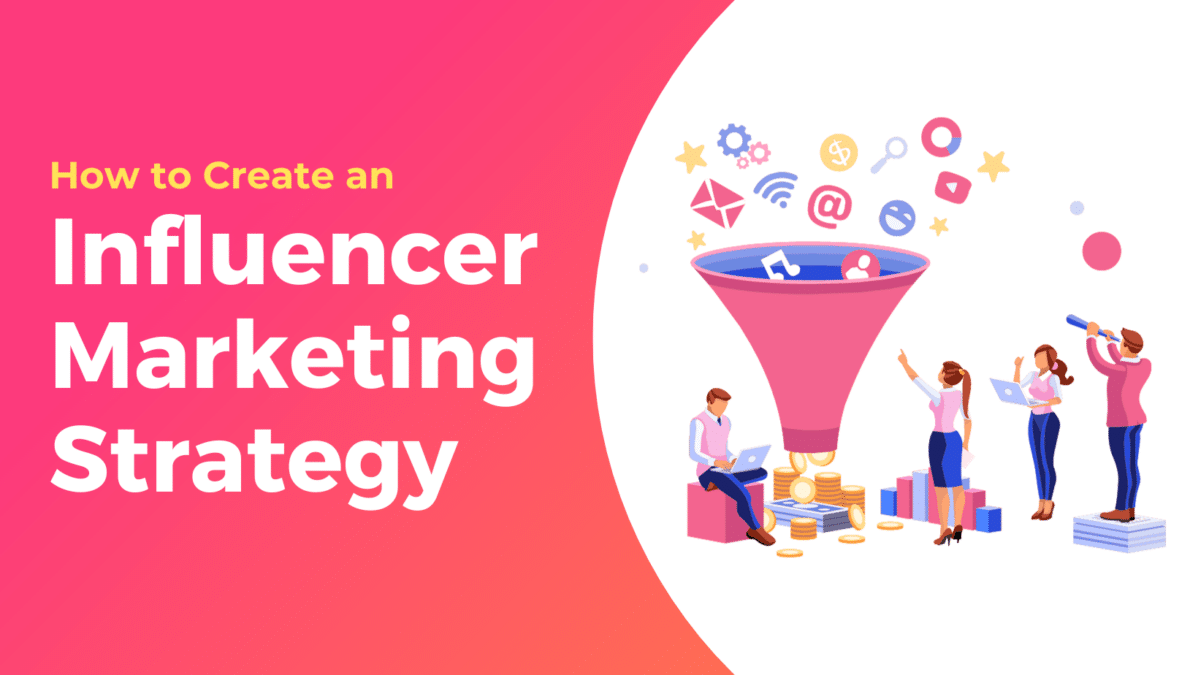
When to Post on TikTok For Best Results
April 26, 2022
Social Media Organization Tips You Need Now
May 9, 2022How to Create an Influencer Marketing Strategy
Develop a successful influencer marketing strategy for your company with these tips
In recent years, influencer marketing has grown in favor among marketers. With the rise of word-of-mouth marketing and social proof, it’s a great way to connect with audience members, enhance brand awareness, and boost conversions. Here’s how to create an influencer marketing strategy.
- Determine your campaign goals.
- Define your campaign audience.
- Set your budget and choose your influencer type.
- Choose your influencer and review their work.
- Develop your campaign messaging for your influencer.
- Finalize campaign expectations with your influencer.
- Pay your influencer.
- Measure your results.
Influencer Marketing Strategy
Let’s look at how our partners at HubSpot think you should develop an influencer marketing strategy for your company. These techniques will help you to control every facet of your influencer engagement. It will also ensure that they are successful in assisting you in achieving your campaign objectives.
1. Determine your campaign goals.
The first step is to create goals for your influencer marketing strategy — these will help you measure the success of your campaign. Think about your objectives in terms of SMART goals.
When working to develop influencer marketing SMART goals, there are three factors to keep in mind: reach, relevance, and resonance. These will help you focus your goals on the different aspects of influencer marketing.
Reach is the ability to deliver content to your target audience through an influencer — it helps you improve brand and product awareness. For example, how many people on Instagram are actually seeing the content an influencer is posting about your product?
Relevance is the level of connection your audience feels to your brand, product, or service due to the work of an influencer — it’ll help you enhance brand loyalty. For example, if your audience sees a celebrity they love and admire with your product, they might begin to feel a strong connection to it, too.
Resonance is the ability to drive audience members to a specific action because of an influencer’s content — it’s all about impact and memorability. Resonance helps you increase your follower count, drive traffic to your site, and boost conversions. For example, if your audience reads a blog post written by an influencer about your product, they may click on the link in the blog post that directs them to your website so they can buy it.
2. Define your campaign audience.
Regardless of which type of influencer you work with, your target audience will remain the same. Different influencers may have different ways of connecting with your audience, but your business’s overall marketing goals and buyer personas don’t change.
Before moving forward with your influencer marketing strategy, work with your marketing team to develop and learn about your buyer personas.
This will help you identify the exact type of customer you’re going after and, therefore, help you determine what type of influencer and content will appeal most to them to ensure your target audience is aligned with that of the influencer.
3. Set your budget and choose your influencer type.
Based on our review of the five major types of influencers, you should be able to determine which type will work best for your business’s goals and target audience. From there, you can start building a budget.
For example, if you’re a startup with a low budget, you might choose to work with a micro-influencer. If you’re a mid-sized company with more resources, you might choose to bring on a celebrity influencer or work with a KOL who’s highly regarded in their industry.
HubSpot Blog Research found that marketers typically pay between $501 and $10K for nano-influencers, micro-influencers, and macro-influencers, with $10K+ budgets reserved for mostly mega influencers.
According to the survey, roughly 90% of marketers have a budget specifically for influencer marketing, with 45% allocating between $100K to $500K.
4. Choose your influencer and review their work.
Once you’ve determined the type of influencer you want to work with, it’s time to identify the right influencer for your company.
Quality of content and engagement are the top two factors marketers review when considering an influencer on social media, according to a 2021 survey from HubSpot Blog Research. Surprisingly, follower count falls fifth on the list, behind alignment with company values and branding.
However, this falls in line with recent data showing that brands are caring less about the size of influencers’ following, as they give more weight to other elements.
When considering someone for a campaign, ask yourself (and the influencer) the following questions:
- Does this influencer and their lifestyle fit my brand image?
- Have they worked with any of my competitors?
- Who is this influencer’s current audience?
- Is my target audience active on the platform/channel primarily used by this influencer?
- Does working with this influencer make sense for my budget?
- Has this influencer actually used any of my products or services before? Are they a customer?
- Does this person have a personality I want to work with?
- What will this influencer expect from me?
How to Find Influencers
5. Develop your campaign messaging for your influencer.
Once you’ve chosen an influencer, it’s time to plug them into your campaign. Work with your marketing team to develop your campaign messaging and determine what content your influencer should (and should not) publish.
Be sure to share your brand guidelines — including details about your brand voice, tag lines, and language to avoid — with your influencers so they can remain on-brand with their content. Remember, whether an influencer posts about your product or service one time or 100 times, they’re still representing your brand and business. Ensure they have the tools to do so accurately.
In this stage, you should also determine whether your influencer will be creating content for your campaign on their own or if you’ll be providing the content for them to post.
Lastly, be sure to discuss how they’re going to help you boost traffic with their content and which target metrics you can expect per post or piece of content.
6. Finalize campaign expectations with your influencer.
Finally, review all of the expectations you have for them in addition to any expectations they have for you. Remember your chosen influencer may have worked with other brands before yours — meaning they may already have their own processes in place for the way they do business.
Additionally, their expectations are going to differ depending on the type of influencer they are. For example, a micro-influencer is going to have different expectations for the way you communicate with them versus a celebrity. A micro-influencer may speak directly with you, whereas a celebrity may have an agent communicate on their behalf.
Lastly, you’ll want to ensure these expectations are written, agreed upon, and signed by both you and the influencer — you can organize all of this information through an influencer contract. This will help you avoid any issues and discrepancies down the road.
To help get the ball rolling, here are some examples of the expectations to review:
- How this influencer will be paid or rewarded (money, swag, discounts, coupon codes, etc.)
- How long you’ll be working together
- How you and the influencer will communicate with each other
- Any other terms of contract necessary for your specific business to review
6. Pay your influencer.
Influencers don’t work for free. You’ll need to discuss compensation early on so you can both be on the same page about what the work will entail if you decide to move forward.
If you’re a small company with little to no influencer budget, there are still ways to collaborate with influencers. You can offer:
- Swag (such as clothing, accessories, or product samples)
- Free products and/or services
- Access to discount codes and coupons
7. Measure your influencer marketing campaign results.
Lastly, you must measure your influencer marketing strategy results. This is how you’ll determine the level of success you’ve had in reaching your audience with the help of the influencer.
According to data from a 2021 HubSpot Blog Research survey, revenue is the most important metric to marketers when measuring the impact of an influencer campaign.
To start, refer back to the SMART goals you set (as well as influencer marketing metrics) to help you determine whether or not you’ve achieved your objectives.
Metrics for working with influencers
Here’s more detail on which metrics you’ll want to keep an eye on when measuring your influencer marketing strategy success:
Engagement: Keep an eye on all engagement involving content shared by the influencer about your brand and products. Engagement includes various interactions such as Likes, Shares, Comments, Retweets, Mentions, Direct Messages, and Reposts on channels like social media, blogs, and forums.
Reach: Determine your reach, or how many people are actually seeing the content your influencer is sharing about your brand, by looking at your overall number of views.
Resonance: Learn about the level of resonance — or the actions that were completed — by your audience members after they consume and/ or interact with the influencer’s content involving your brand.
Brand Awareness: Measure your brand awareness among the audience members of your influencer as they begin sharing content related to your brand. There are quantitative — such as direct traffic and social engagement — and qualitative — such as social listening and awareness surveys — ways to measure your brand awareness.
Clicks: Review the number of clicks on the content the influencer shares about your brand, whether it’s a direct link to your website, a CTA, a social media giveaway, or a signup form.
Conversions: Calculate your conversions (the number of leads who become customers) as a result of your influencer marketing strategy. You can calculate conversions on your website or through URLs (such as discount/ checkout codes found on the influencer’s social media account or blog) by dividing your conversions by your overall number of visitors.
Return on Investment (ROI): Calculate the return on your influencer marketing investment by dividing the return (or benefit) by the cost of the influencer marketing investment.
Follower Count: Track the increase and decrease of your number of social media followers or blog subscribers over time to see whether or not the influencer is helping you boost your follower and/ or subscriber count.
Measuring the success of influencer marketing
In terms of measuring the success of the influencer’s work, BuzzStream and BuzzSumo both have analytics tools built into the software to help you measure the success of the influencer’s work. These types of software are especially helpful in allowing you to determine ROI from your influencer marketing strategy, which is known to be the most difficult metric to measure when working with an influencer for businesses.
Google Analytics is great if you want to track overall traffic directed to your website and the number of leads converted. The software provides you with a deep look at acquisition, behavior, and conversions related to an influencer and your visitors.
For example, if you ask the influencer to conduct a giveaway or contest, look at the number of people who participated. Say you give the influencer a discount code for audience members to use at checkout — see how many people used it to make a purchase.
If you provide the influencer with specific URLs with tags to specific posts or landing pages, you can also track their performance by looking at the number of leads directed to those pages.
Now, onto measuring influencer marketing success on social media. HubSpot’s Social Tool can help you pull specific engagement-related data, like reach and interactions, from various platforms. Additionally, the respective social platforms you’re using may have analytics tools built-in as well, such as Twitter Analytics and Instagram Insights.
Your Influencer Marketing Strategy
Influencer marketing has become a popular marketing tactic for businesses looking to boost their online presence and reach new audiences. To create a successful influencer marketing strategy, it’s important to start by defining campaign goals, determining the target audience, setting a budget, and selecting the right type of influencer.
Choosing the right influencer involves reviewing their work and aligning campaign messaging with their personal brand. Once an influencer is selected, it’s important to finalize expectations and pay them. Finally, measuring results is key to evaluating the success of the campaign and making adjustments for future efforts.
By following these steps, companies can develop a successful influencer marketing strategy that effectively reaches and engages their target audience.




